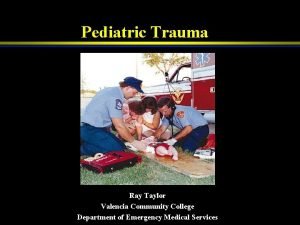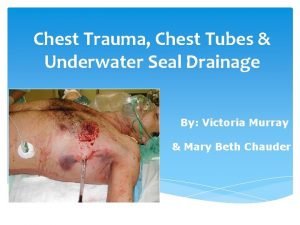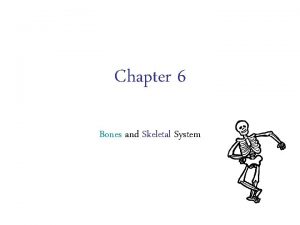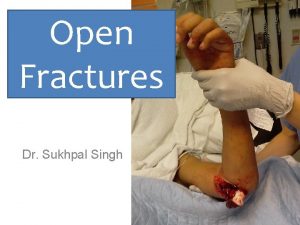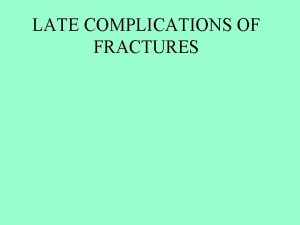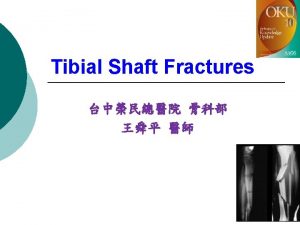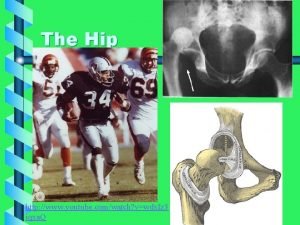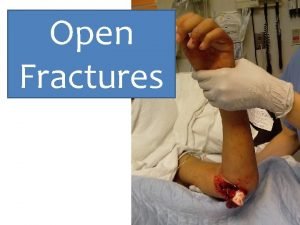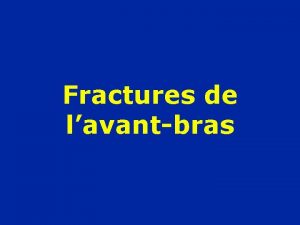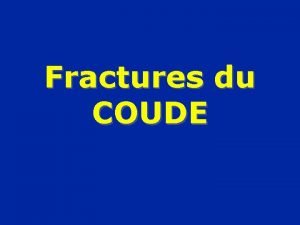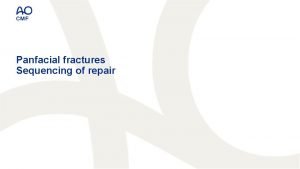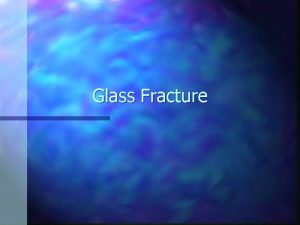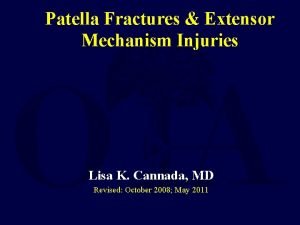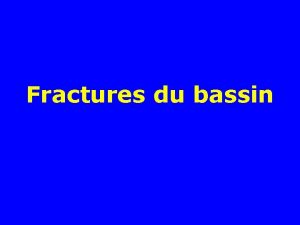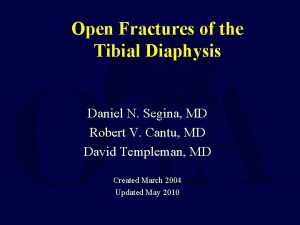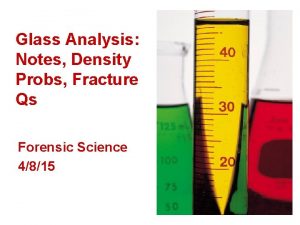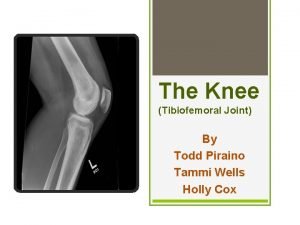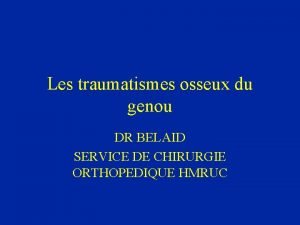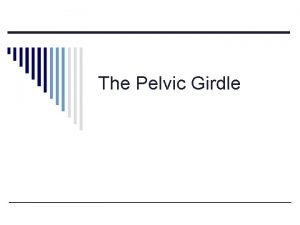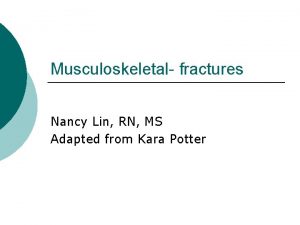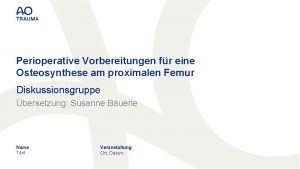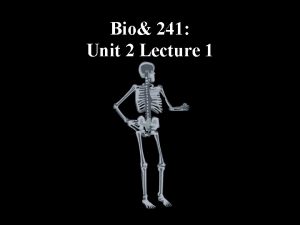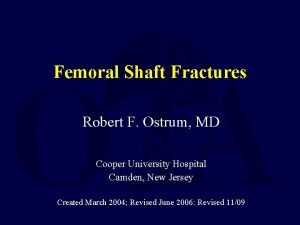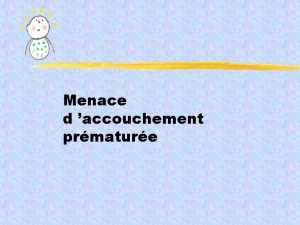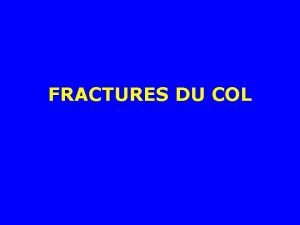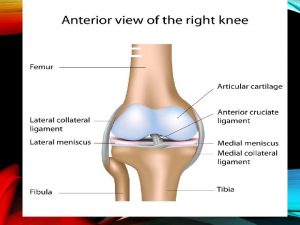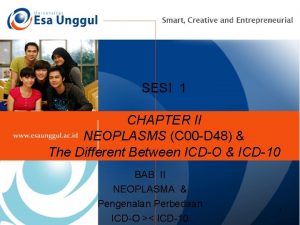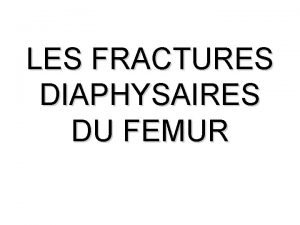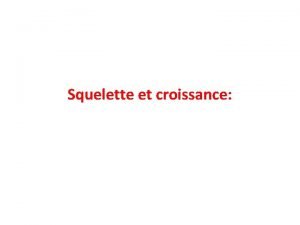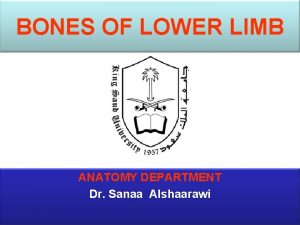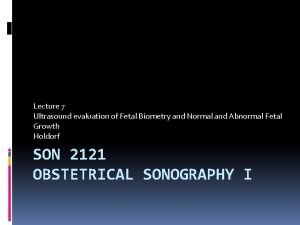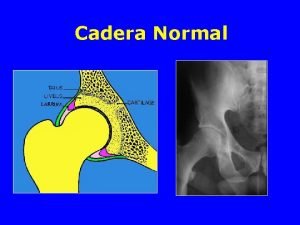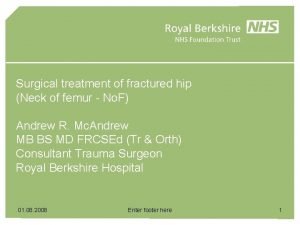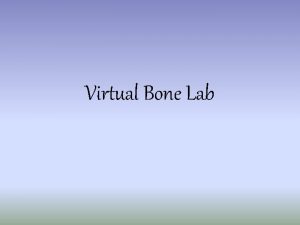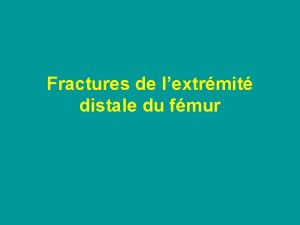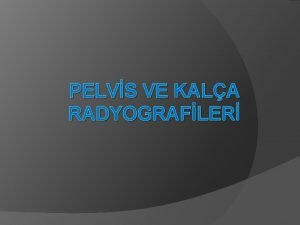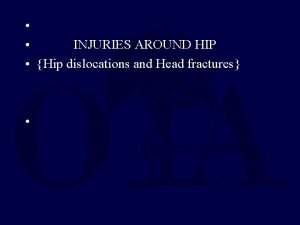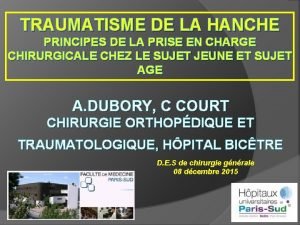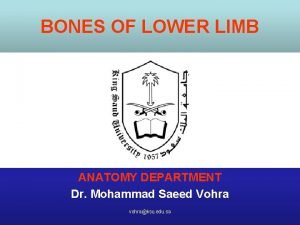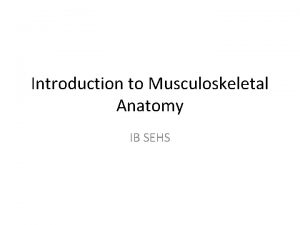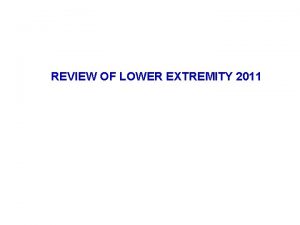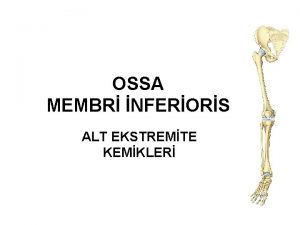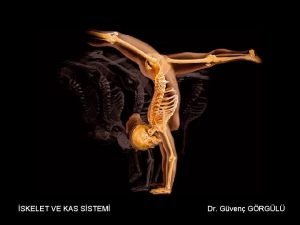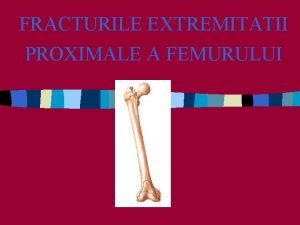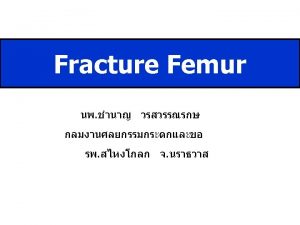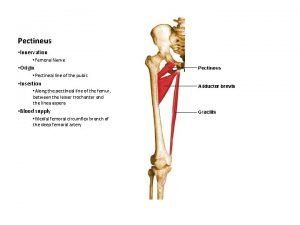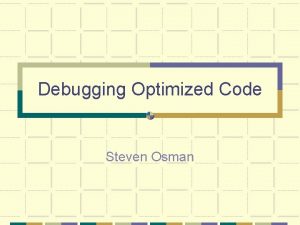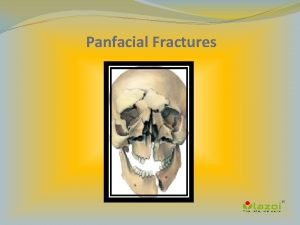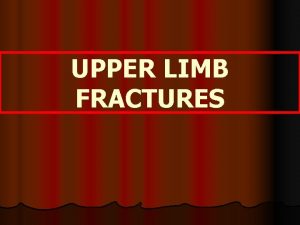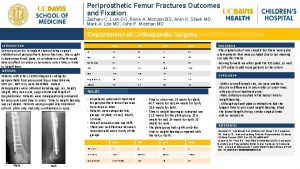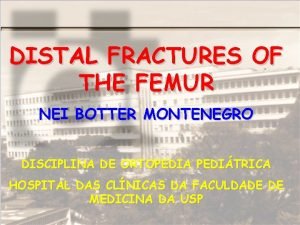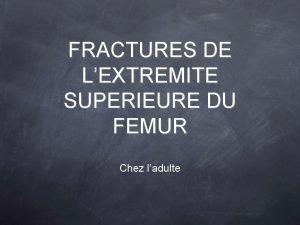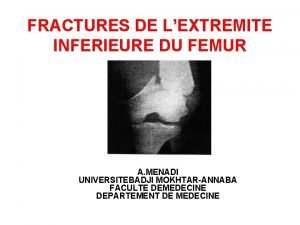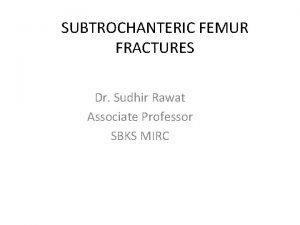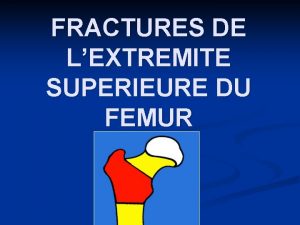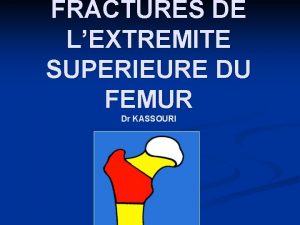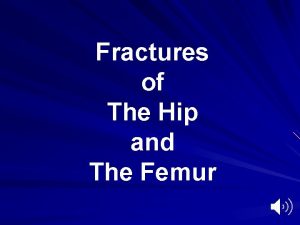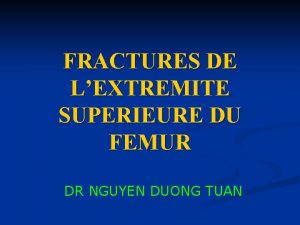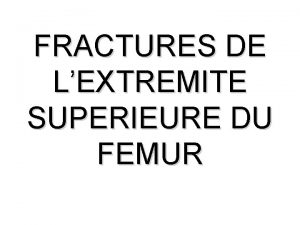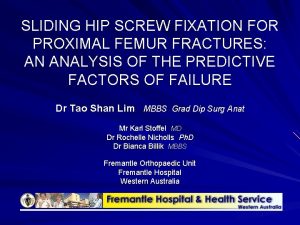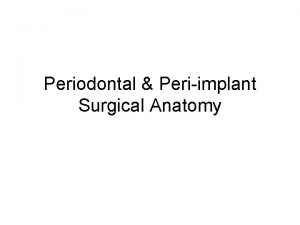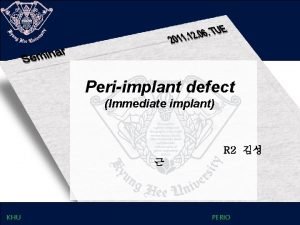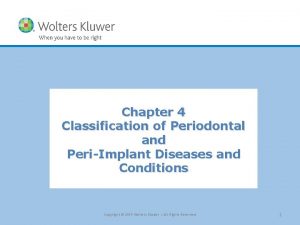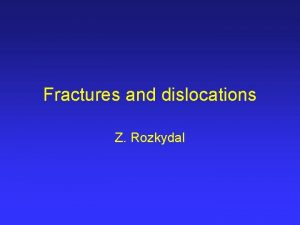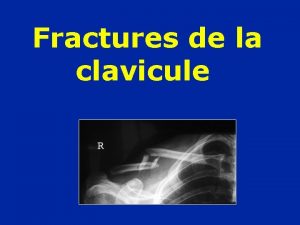Treatment of PeriImplant Fractures of the Femur Steven






































































































- Slides: 102

Treatment of Peri-Implant Fractures of the Femur Steven I. Rabin Dreyer Medical Clinic Created January 2006 Revised August 2009

Fractures around Implants Pose Unique Fixation Challenges

Number of Implants in the Femur are Increasing • Population is Aging • Joint Replacement Indicated More Often • Fracture Fixation Indicated More Often

Increasing Number of Implants in the Femur • Over 123, 000 Total Hip Replacements • Over 150, 000 Total Knee Replacement each year in the United States Numbers Expected To Increase with Aging Population

Increasing Number of Implants in the Femur • Over 300, 000 Hip Fractures each year in the United States almost all are treated surgically with internal fixation or prosthetic replacement

As the Number of Implants Placed Increases the Number of Associated Fractures will Increase

High Mortality after Periprosthetic Hip Fracture • Mortality following a periprosthetic hip fracture (89% 1 -year survival) is: – significantly greater than the mortality after primary total hip replacement (97% 1 -year survival) in matched patients – And statistically similar to the mortality following hip fractures (83. 5%)

Pre-Operative Planning • As with all fracture fixation surgery, pre-operative planning is essential. • Planning begins with classification • Templating is extremely valuable • Surgeon must be sure that he/she has an adequate selection of specialized implants available – Including cables, special plates & screws of appropriate size and length

Be Prepared! • The surgeon may need to use specialized implants not usually kept “on the shelf” at his/her hospital. – Examples include specialized peri-prosthetic screws, claw plates for the greater trochanter, cable systems, and broken screw/implant removal devices

Classification • The most commonly used classifications for periprosthetic fractures around hip replacements are the Vancouver and AAOS classifications. • The most commonly used classification for periprosthetic fractures around knee replacements is the Neer classification.

Vancouver Classification of Periprosthetic Hip Replacement Fractures • Type A: • Fracture at the trochanters – AL at lesser trochanter – AG at greater trochanter • Illustrations from Duncan CP and Masri BA: Fractures of the Femur after hip replacement. Instr Course Lect 44: 293 -304, 1995

Vancouver Classification of Periprosthetic Hip Replacement Fractures • Type B 1: fracture is around or just below a well-fixed stem

Vancouver Classification of Periprosthetic Hip Replacement Fractures • B 2 – Fracture is around or just below a loose stem

Vancouver Classification of Periprosthetic Hip Replacement Fractures • B 3 – Fracture is around or just below a stem with poor proximal femoral bone stock

Vancouver Classification of Periprosthetic Hip Replacement Fractures • Type C – Fracture Well Below the Stem

AAOS Classification of Peri. Prosthetic Hip Fractures • Level I: (Proximal to Lesser Trochanter) – Type I: proximal to the intertrochanteric line – Type II: vertical split above lesser trochanter • Level II: (<10 cm. distal to Lesser Trochanter) – Type III: Split below the lesser trochanter • Level III: (>10 cm. distal to Lesser Trochanter) – Type IV: Fracture at the tip of the stem. • A: spiral • B: short oblique or transverse – Type V: Severely comminuted Type III or IV – Type VI: Fracture distal to the prosthesis

Neer Classification of Periprosthetic Knee Replacement Fractures • Type I: Extra-articular or Non-displaced Femur Fx – <5 mm of displacement or > 5 degrees angulation • Type II: Extra-articular Femur Fx – >5 mm of displacement or > 5 degrees angulation • Type III: Comminuted Femur Fx. • Type IV: Fractures at the Tip of Stemmed Femoral Prostheses • Type V: Tibial fracture

Fractures around Implants: Unique Fixation Challenges • Original Placement of the Implant may predispose to later fracture • Long Term Presence of the Implant may change the structure of bone and increase susceptibility of fracture • Implant Itself may interfere with healing or the placement of fixation devices

Peri-Implant Fractures May be Caused by Technical Problems During Implant Placement

Risk Factors for Intra-operative Periprosthetic Fractures • For patients with hip replacements: increased risk of periprosthetic fracture if: – Press-fit implant • (larger prosthesis compared to medullary canal) – Long Stem implant • (mis-match between stem and femoral bow) – Revision Procedure • (compromised bone stock) • (cement removal – 44% risk of intra-operative fracture) • (impaction bone grafting techniques 4 -32% risk) – Limited Incision technique 3% risk • (poorer visualization of the anatomy)

Technical Problems during Implant Placement include: • Notching Anterior Femoral Cortex during Knee Replacement • Cracking Calcar during Hip Replacement • Penetrating Shaft during Hip Replacement • Cracks between Screw Holes during Internal Fixation

Notching Anterior Femoral Cortex During Knee Replacement May have 40% fracture rate at 8 years Figgie et. al. J. Arthroplasty 1990

• Incidence of Supracondylar Femur Fracture after Total Knee Replacement: . 6 to 2. 5%

Fracture Associated with Implant Placement • Fracture of the Femoral Neck may occur with Antegrade Intramedullary Rodding • Stress Riser at Insertion Site

Calcar May Fracture During Hip Arthroplasty If the prosthesis or trials are not properly sized

Femoral Stem may Perforate the Femoral Shaft During Hip Replacement especially if the femur is bowed 3. 5% fracture rate during Primary Total Hip Replacement Shaw & Greer, 1994

Greater Trochanteric Fracture • Greater Trochanteric fractures can occur during placement of a total hip prosthesis, during removal, or due to a separate traumatic injury • Options for fixation include cerclage wires or a claw plate. Zarin, JS, Zurakowski, D, and Burke, DW: J Arthroplasty. 2009 Feb; 24(2): 272 -80 Claw Plate Fixation of the Greater Trochanter in Revision Total Hip Arthroplasty

The Bone Can Crack Between Screw Holes During Internal Fixation Especially in osteoporotic bone

Stress Risers During Internal Fixation • Any Drill Hole up to 20% of the bone’s diameter will weaken bone by 40% – 90% of fractures around fixation implants occur through a drill hole – Koval et. al. 1994

Stress Risers During Internal Fixation • Fractures Tend to Occur at the End of Implants where weaker bone meets the rigid device

Fractures can occur Postoperatively • Incidence of 0. 6 – 2. 5% of hip fractures

Fractures Associated with Implant Removal • During Prosthetic Revisions – 17. 6% fracture rate compared to 3. 5% during primary hip replacements – (5 times the rate for primary hip replacement) – through osteoporotic bone or osteolytic defects

Fractures Associated with Implant Removal • Zickel IM Nails – are associated with Subtrochanteric Fractures after Removal • Plates Stress Shield – Cortical bone - increased rate of fractures after removal (especially forearm)

Problems with Treating Peri-Implant Fractures • Implants may block new fixation devices – Stems, rods, and bone cement may fill the medullary canal preventing IM fixation of fractures – Stems and rods may also block screw fixation through the medullary canal to hold plates on bone • Implants may impair healing due to endosteal ischemia • Defects in bone from Osteolysis, Osteoporosis, and Implant Motion may compromise fixation

Peri-Implant Fracture Fixation Methods • Follow Standard Principles of Fixation • Must Achieve Stable Anatomic Fixation while Preserving Soft Tissue Attachments • Indirect Reduction Techniques • Careful Preoperative Planning • Intra-Operative Flexibility/Creativity • Choose the Device That Fits the Patient

Periprosthetic Femur Fractures • Treatment Options are: – Long-stem revision arthroplasty – Cortical strut allografting – Plate fixation with screws – Plate fixation with cables – Intramedullary Devices

Treatment Options Most Important Factor in Treating Peri-Implant Fractures is the Status of the Implant

• When the Implant is Loose, Mal-aligned or Deformed – Consider Revision/Replacement

• When the Implant is Stable, and Well Aligned with Good Quality Bone – Consider Fixation

Implant Revision/Replacement • Avoids potential difficulties of fixation – does not have to avoid the implant – does not require stable fixation in poor bone • Avoids potential complications of malunion or nonunion • Indicated if Implant is Loose, Mal-Aligned, Deformed or there is Poor Bone Quality

Case Example 1: Revision of Loose Prosthesis Complicated by Fracture • 82 y/o F – Pre-existing LOOSE Hip Replacement – Fell sustaining Peri. Prosthetic Femoral Shaft Fracture – X-ray Findings: Osteolysis, Subsidence

Case Example 1: Revision of Loose Prosthesis Complicated by • 82 y/o F Fracture – Treatment: Prosthesis Removal, Strut Medial Allograft, and Long Stem Femoral Revision – Follow-up - allograft incorporated and prosthesis stable with healed fracture at 6 months

Case Example 2: Hip Replacement after Fracture at Tip of DHS Implant • Elderly M – DHS for Intertrochanteric Hip Fracture Fixation

Case Example 2: Hip Replacement after Fracture at Tip of DHS Implant • Elderly M – Intertrochanteric Fracture Healed – Fell 1 year later sustaining Femoral Neck Fracture at tip of lag screw – X-rays showed poor bone stock

Case Example 2: Hip Replacement after Fracture at Tip of DHS Implant • Elderly M – Treatment: Hardware Removal, Hemiarthroplasty – Follow-up : Functioning well at 6 months

Fixation Around An Implant • Avoids Difficulties of Implant Removal – may be technically difficult – may be time-consuming – may cause further fracturing of bone • Indicated if Implant is Stable, Well Aligned, and Bone Quality is Good

Peri-Implant Fracture Fixation • A Wide Selection of Devices Must be Available: – Special Plates with Cerclage Wires • Curved Plates to Match the anterior Bow of the Femur are Now Available. – Flexible Intramedullary Rods – Rigid Intramedullary Rods

Plating Techniques for Peri-Implant Fractures • Advantages of Plates: – Allow Direct Fracture Reduction and Exact Anatomic Alignment • Less Chance of Later Prosthetic Loosening due to Mechanical Mal -alignment – Allow Interfragmentary Compression and A Rigid Construct for Early Motion

Plating Techniques for Peri-Implant Fractures • Disadvantages of Plates: – Biologic and Mechanical Disadvantages Compared to IM devices even with Indirect Techniques – Require Special Plates which accept Cerclage Wires, and/or allow Unicortical Screws and/or match the shape of the bone

Case Example 3: Fracture at the Proximal End of a Supracondylar Nail Treated with a Plate • Elderly F – Pre-existing healed supracondylar femur fracture – New fracture at end of rod after MVA – Treatment: ORIF with Plate/wires – Follow-up: Healed after 3 months and still asymptomatic at 2 years

Peri. Prosthetic Fracture For Hip Peri. Prosthetic Fixation -Standard is with Plate or Allograft or

Allograft Technique • Picture/x-ray courtesy of Dr. John Cardea

Plate Technique • Advantages of Plate over Allograft – Less Invasive • Leaves Medial Soft Tissues Intact – Avoids Potential Allograft Risks • Including Donor Infection – Stronger • Allograft bone can be Brittle

Combined Allograft Struts & Plates • Mechanically the use of allograft struts and plates has been found to be stronger than plates alone (with or without locking screws) – Rad Zdero, Richard Walker, James P. Waddell, and Emil H. Schemitsch Biomechanical Evaluation of Periprosthetic Femoral Fracture Fixation J. Bone Joint Surg. Am. , May 2008; 90: 1068 - 1077. • Although this study was in vitro and so did not take into account the additional biologic trauma inherent in placing the allograft struts

Recent Clinical Studies Controversial • M. A. Buttaro, G. Farfalli, M. Paredes Núñez, F. Comba, and F. Piccaluga Locking Compression Plate Fixation of Vancouver Type-B 1 Periprosthetic Femoral Fractures J. Bone Joint Surg. Am. , Sep 2007; 89: 1964 - 1969. – Conclusion: Plate Fixation Should be Supplemented by Allograft Struts • Catherine F. Kellett, Petros J. Boscainos, Anthony C. Maury, Ari Pressman, Barry Cayen, Paul Zalzal, David Backstein, and Allan Gross Proximal Femoral Allograft Treatment of Vancouver Type-B 3 Periprosthetic Femoral Fractures After Total Hip Arthroplasty. Surgical Technique J. Bone Joint Surg. Am. , Mar 2007; 89: 68 - 79. – Conclusion: Allograft Struts alone are enough. Plates not necessary. • William M. Ricci, Brett R. Bolhofner, Timothy Loftus, Christopher Cox, Scott Mitchell, and Joseph Borrelli, Jr. Indirect Reduction and Plate Fixation, without Grafting, for Periprosthetic Femoral Shaft Fractures About a Stable Intramedullary Implant. Surgical Technique J. Bone Joint Surg. Am. , Sep 2006; 88: 275 - 282. – Conclusion: Plate fixation alone is enough. Struts not necessary.

Peri. Prosthetic Fracture Plate or allograft attachment is by Cerclage Wires or unicortical screws or

Plate Techniques May Use Cables to attach the plate to the bone • Cables – Require Extensive Exposure – And are Technically Demanding – So the fewer Used, the Better: To decrease operative trauma and operating time • Pictures courtesy of Dr. John Cardea

Plate Techniques Can Also Use Screws to Attach the Plate to Bone • Screws – Can be Placed Easier than Cables – And Can be Placed Percutaneously with less soft tissue trauma than Cables • So using Screws instead of Cables should decrease operative trauma and operating time

Use of plates with cables: There are many reports • Examples: -Ogden and Rendall, Orthop Trans, 1978 -Zenni, et al, Clin Orthop, 1988 -Berman and Zamarin, Orthopaedics, 1993 -Haddad, et al, Injury, 1997 But none of these address the question: how many cables are necessary?

Cables: • Cables resist bending loads: -Mihalko, et al, J Biomechanics, 1992 • BUT Cables resist torsional loads poorly compared to screws -Schmotzer, et al, J Arthroplasty, 1996 The Use of Screws should improve Rotational Stability

Peri. Prosthetic Fracture • Cerclage Wires are Less Mechanically Sound than Unicortical Screws • Lohrbach & Rabin Mid. America Orthopedic Assoc. Annual Meeting 2002

Conclusions: • A unicortical screw significantly increases torsional and A-P stability and should be added to cableplate constructs • At least six cables are needed in the absence of a unicortical screw to improve A-P and rotational stability Lohrbach & Rabin Mid. America Orthopedic Assoc. Annual Meeting 2002

Case Example 4: Fracture at Distal End of Hip Replacement Stem Treated with a Standard Plate • Elderly F – Pre-existing Asymptomatic Hip Arthroplasty – Fell out of a car sustaining fracture at tip of stem – X-rays showed a solid prosthesis

Case Example 4: Fracture at Distal End of Hip Replacement Stem Treated with a Standard Plate • Elderly F – Treatment: DCP plate w. screws/cerclage wires – Follow-up: Healed/Asymptomatic at 3 years

Case Example 5: Peri-Prosthetic Fracture Treated with Locking Compression Plate • 73 y/o M – Healthy – 3 previous platings

Case Example 5: Peri-Prosthetic Repair with Locking Plates • Treatment = Double Locked Compression Plate, electrical stimulator, Hardware removal • Locking Screw Plates are Ideal because they provide stable fixed angled unicortical fixation

Case Example 5: Peri-Prosthetic Repair with Locking Plates – Clinically painless by 6 weeks – Radiographically appeared healed at 2 months – Follow-up 13 months – Complication: S. epi post-op infection required I&D & e-stim removal at 3 months

Case Example 6: Peri-Prosthetic Repair with LISS Plate • 49 y/o F – Healthy: Fracture at end of Hip Stem – 3 previous platings, – 1 previous retrograde rod

Case Example 6: Peri-Prosthetic Repair with LISS • Treatment = LISS + locking plate, electrical stimulator, bone graft • (LISS – less invasive stabilization system)

Case Example 6: Peri-Prosthetic Repair with LISS – Follow-up 19 mo. – No Pain by 2 mo. – Bridging 5 mo.

Case Example 7: Fracture Distal to Hip Stem Treated with Curved Locking Plate 72 y/o Male with Hip Replacement for Arthritis X-ray from Routine Annual Followup (6 months prior to fracture)

Case 7: Treatment with • Curved Plate Fracture

Case 7: Curved Plate Intra-op • Curved Plate Matches Bow of Femur

Case 7: Curved Plate Example Healed at 6 months

Flexible Intramedullary Rods (Zickel, Enders etc. ) • Flexible Rods Advantages: – can be placed via minimal incisions – act as internal splints until fracture healing

Flexible Intramedullary Rods • Flexible Rods Disadvantages: – require external protection (cast or brace) – rarely allow early motion or weight-bearing – must be enough space in the medullary canal for implant and rod

Case Example 8: Distal Femur Fracture w. Proximal Hip Replacement Treated with Flexible IM Rod • Elderly F s/p MI – Pre-existing Asymptomatic Hip Hemiarthroplasty – Fall sustaining distal femur shaft fracture – X-rays showed wide medullary canal and osteoporosis

Case Example 8: Distal Femur Fracture w. Proximal Hip Replacement Treated with Flexible IM rod • Elderly F s/p MI – Treatment: Zickel Supracondylar Device – Follow-up: Healed Asymptomatic at 3 yrs

Rigid Intramedullary Rods (Antegrade, Supracondylar, Retrograde) • Rigid Rod Advantages: – Do Not Require External Support – Provide Rigid Fixation – Biologic & Mechanical Advantages of Intramedullary Position

Rigid Intramedullary Rods • Rigid Rod Disadvantages: – Cannot be used with a pre-existing stemmed implant

Case Example 9: Fracture at the End of a Blade Plate Treated with a Retrograde Nail • Young M – 2 yrs after healed subtrochanteric hip fracture with retained blade plate – In a High Speed Motor Vehicle Accident, sustained a fracture at the distal end of the plate

Case Example 9: Fracture at the End of a Blade Plate Treated with a Retrograde Nail • Young M – 2 yrs after healed subtrochanteric hip fracture with retained blade plate – Treatment: Retrograde Rodding – Follow-up: at 2 years healed and asymptomatic

Case Example 10: Fracture Above a Total Knee Replacement Treated w. an Antegrade Nail • Elderly F – Bilateral Knee Replacements – Sustained Bilateral Distal Femur Fractures Proximal to Knee Replacements after MVA

Case Example 10: Fracture Above a Total Knee Replacement Treated w. an Antegrade Nail • Elderly F – Bilateral Knee Replacements – Treatment: Bilateral Antegrade Rodding – Follow-up: at 3 years: Fractures healed and both knees asymptomatic

Summary • If the prosthesis or implant is Loose, or Bone Quality is Poor - then the implant should be revised while fixing the fracture • If the prosthesis or implant is Stable and Bone Quality is Adequate for Fixation the implant should be retained while the fracture is fixed following standard principles

Remember: If Fixation is chosen: Follow Principles of Good Fracture Care

Case Example 11: Revision of Fixation Requiring Osteotomy • 78 y/o Female: X-rays from 7 years ago after treatment of infected intertrochanteric nonunion Asymptomatic in interim

Example 11: Revision of Fixation • Femoral Neck Fracture • (Vertical Shear Pattern)

Example 11: Revision of Fixation • Fixation of fracture with Valgus Intertrochanteric Osteotomy restores leg length and converts shear forces across the femoral neck fracture into compressive forces

Example 11: Revision of Fixation • Healing at 3 months: • (Plans to shorten blade)

Warning! • The Bone Quality Must be Adequate to Hold Fixation in addition to Stability of the Implant if Fixation is chosen instead of revision/replacement.

Example 12: Stable Prosthesis But Poor Bone Quality • 90 year old Female with asymptomatic Hemi-arthroplasty at annual follow-up

Example 12: Stable Prosthesis But Poor Bone Quality • Fracture • 2 months later

• Example 12: Stable Prosthesis But Poor Bone Quality Stable Prosthesis so Fixation with curved locked plate with Unicortical screws Chosen for Treatment

Example 12: Stable Prosthesis But Poor Bone Quality • Plate Failure At 3 months

Example 12: Stable Prosthesis But Poor Bone Quality • Salvage with Proximal Femoral Replacement

Conclusions • Surgeon must carefully Evaluate Stability of the Implant • Loose Fixation Implants will allow motion at the fracture site that interferes with healing and gets in the way of more stable fixation devices • Loose Prosthetic Implants will be painful and also interfere with adequate fixation

Conclusions If the prosthesis or implant is Loose, or Bone Quality is Poor the implant should be revised while fixing the fracture

Conclusions If the prosthesis or implant is Stable and Bone Quality is Adequate for Fixation the implant should be retained while the fracture is fixed following standard principles

Review Articles • Edward T. Su, Hargovind De. Wal, and Paul E. Di Cesare Periprosthetic Femoral Fractures Above Total Knee Replacements J. Am. Acad. Ortho. Surg. , January/February 2004; 12: 12 – 20 • Scott P. Steinmann and Emilie V. Cheung Treatment of Periprosthetic Humerus Fractures Associated With Shoulder Arthroplasty J. Am. Acad. Ortho. Surg. , April 2008; 16: 199 - 207. Darin Davidson, Jeffrey Pike, Donald Garbuz, Clive P. Duncan, and Bassam A. Masri Intraoperative Periprosthetic Fractures During Total Hip Arthroplasty. Evaluation and • Management • J. Bone Joint Surg. Am. , Sep 2008; 90: 2000 - 2012. Neil P. Sheth, David I. Pedowitz, and Jess H. Lonner Periprosthetic Patellar Fractures J. Bone Joint Surg. Am. , Oct 2007; 89: 2285 - 2296.

Selected References • Rad Zdero, Richard Walker, James P. Waddell, and Emil H. Schemitsch Biomechanical Evaluation of Periprosthetic Femoral Fracture Fixation J. Bone Joint Surg. Am. , May 2008; 90: 1068 - 1077. • Timothy Bhattacharyya, Denis Chang, James B. Meigs, Daniel M. Estok, II, and Henrik Malchau Mortality After Periprosthetic Fracture of the Femur J. Bone Joint Surg. Am. , Dec 2007; 89: 2658 - 2662. • • • William M. Ricci, Brett R. Bolhofner, Timothy Loftus, Christopher Cox, Scott Mitchell, and Joseph Borrelli, Jr. Indirect Reduction and Plate Fixation, without Grafting, for Periprosthetic Femoral Shaft Fractures About a Stable Intramedullary Implant. Surgical Technique J. Bone Joint Surg. Am. , Sep 2006; 88: 275 - 282. Gregg R. Klein, Javad Parvizi, Venkat Rapuri, Christopher F. Wolf, William J. Hozack, Peter F. Sharkey, and James J. Purtill Proximal Femoral Replacement for the Treatment of Periprosthetic Fractures J. Bone Joint Surg. Am. , Aug 2005; 87: 1777 - 1781. Zarin, JS, Zurakowski, D, and Burke, DW: J. Arthroplasty. 2009 Feb; 24(2): 272 -80 Claw Plate Fixation of the Greater Trochanter in Revision Total Hip Arthroplasty

Selected References • • Orthop Clin North Am. 1999 Apr; 30(2): 249 -57 The treatment of periprosthetic fractures of the femur using cortical onlay allograft struts. Brady OH, Garbuz DS, Masri BA, Duncan CP. Instr Course Lect. 1998; 47: 237 -42. Periprosthetic fractures of the femur: principles of prevention and management. Garbuz DS, Masri BA, Duncan CP. Instr Course Lect. 1998; 47: 251 -6. Periprosthetic hip and knee fractures: the scope of the problem. Younger AS, Dunwoody I, Duncan CP. Am J Orthop. 1998 Jan; 27(1): 35 -41 One-stage revision of periprosthetic fractures around loose cemented total hip arthroplasty. Incavo SJ, Beard DM, Pupparo F, Ries M, Wiedel J. Instr Course Lect. 2001; 50: 379 -89. Periprosthetic fractures following total knee arthroplasty. Dennis DA Orthop Clin North Am. 2002 Jan; 33(1): 143 -52, ix. Periprosthetic fractures of the femur. Schmidt AH, Kyle RF J Arthroplasty. 2002 Jun; 17(4 Suppl 1): 11 -3. Management of periprosthetic fractures: the hip. Berry DJ. Clinical Orthopaedics & Related Research. (420): 80 -95, March 2004. Periprosthetic Fractures Evaluation and Treatment. Masri, Bassam; Meek, R M. Dominic; Duncan, Clive P If you would like to volunteer as an author for the Resident Slide Project or recommend updates to any of the following slides, please send an email to ota@ota. org Return to Lower Extremity Index
 Femur femur
Femur femur Canthatomy
Canthatomy Chest tube management
Chest tube management Types of fractures with pictures
Types of fractures with pictures Classification of open fractures
Classification of open fractures Perkins timetable fracture healing
Perkins timetable fracture healing Gustilo anderson classification antibiotics
Gustilo anderson classification antibiotics Primary bone vs secondary bone
Primary bone vs secondary bone Tennis elbow irving
Tennis elbow irving Ilioposas
Ilioposas Classification of open fractures
Classification of open fractures øpas
øpas Supracondylienne
Supracondylienne Panfacial fractures sequencing
Panfacial fractures sequencing Radial fracture glass
Radial fracture glass Triradiate cartilage
Triradiate cartilage Types of fractures with pictures
Types of fractures with pictures Classification tile bassin
Classification tile bassin Weber classification
Weber classification Daniel tibia
Daniel tibia Activity 14-1 glass fracture patterns answer key
Activity 14-1 glass fracture patterns answer key Types of glass fractures
Types of glass fractures Greater trocanter
Greater trocanter Innervation of biceps femoris short head
Innervation of biceps femoris short head Bota de traccion cutanea
Bota de traccion cutanea Fracture de la rotule classification de moulay et ricard
Fracture de la rotule classification de moulay et ricard Pelvic extension
Pelvic extension Skeletal traction femur
Skeletal traction femur Femur proximal übersetzung
Femur proximal übersetzung Obturator foramen
Obturator foramen Piriform fossa femur
Piriform fossa femur Hauteur utérine
Hauteur utérine Clou gamma long
Clou gamma long Patellar tendinitis moi
Patellar tendinitis moi Kode icd 10 oat
Kode icd 10 oat Exercice rééducation fracture fémur
Exercice rééducation fracture fémur Schéma de l'articulation du genou
Schéma de l'articulation du genou Ligamento popliteo arqueado
Ligamento popliteo arqueado Icd 10 fraktur femur
Icd 10 fraktur femur Fémur
Fémur Borders and surfaces of femur
Borders and surfaces of femur Femur length
Femur length Arco di shenton
Arco di shenton Femur projections
Femur projections Neck of femur
Neck of femur Canaliculi
Canaliculi Fracture de trelat
Fracture de trelat Pelvis lateral radyografi pozisyonu
Pelvis lateral radyografi pozisyonu Acetabulum fracture
Acetabulum fracture Vissage en triangulation
Vissage en triangulation Femur borders
Femur borders Difference between femur and humerus
Difference between femur and humerus Unlocking of knee joint
Unlocking of knee joint Femur kemik
Femur kemik Jugular notch
Jugular notch Fractura hoffa femur
Fractura hoffa femur Film femur
Film femur Pectineus origin
Pectineus origin Subtrochanteric
Subtrochanteric Các châu lục và đại dương trên thế giới
Các châu lục và đại dương trên thế giới Bổ thể
Bổ thể Từ ngữ thể hiện lòng nhân hậu
Từ ngữ thể hiện lòng nhân hậu Diễn thế sinh thái là
Diễn thế sinh thái là Tư thế ngồi viết
Tư thế ngồi viết V. c c
V. c c Phép trừ bù
Phép trừ bù Thể thơ truyền thống
Thể thơ truyền thống Chúa yêu trần thế
Chúa yêu trần thế Hổ đẻ mỗi lứa mấy con
Hổ đẻ mỗi lứa mấy con đại từ thay thế
đại từ thay thế Vẽ hình chiếu vuông góc của vật thể sau
Vẽ hình chiếu vuông góc của vật thể sau Công của trọng lực
Công của trọng lực Thế nào là mạng điện lắp đặt kiểu nổi
Thế nào là mạng điện lắp đặt kiểu nổi Tỉ lệ cơ thể trẻ em
Tỉ lệ cơ thể trẻ em Lời thề hippocrates
Lời thề hippocrates Vẽ hình chiếu đứng bằng cạnh của vật thể
Vẽ hình chiếu đứng bằng cạnh của vật thể độ dài liên kết
độ dài liên kết Quá trình desamine hóa có thể tạo ra
Quá trình desamine hóa có thể tạo ra Các môn thể thao bắt đầu bằng tiếng nhảy
Các môn thể thao bắt đầu bằng tiếng nhảy Khi nào hổ mẹ dạy hổ con săn mồi
Khi nào hổ mẹ dạy hổ con săn mồi điện thế nghỉ
điện thế nghỉ Dạng đột biến một nhiễm là
Dạng đột biến một nhiễm là Thế nào là sự mỏi cơ
Thế nào là sự mỏi cơ Trời xanh đây là của chúng ta thể thơ
Trời xanh đây là của chúng ta thể thơ Voi kéo gỗ như thế nào
Voi kéo gỗ như thế nào Thiếu nhi thế giới liên hoan
Thiếu nhi thế giới liên hoan Vẽ hình chiếu vuông góc của vật thể sau
Vẽ hình chiếu vuông góc của vật thể sau Các châu lục và đại dương trên thế giới
Các châu lục và đại dương trên thế giới Một số thể thơ truyền thống
Một số thể thơ truyền thống Thế nào là hệ số cao nhất
Thế nào là hệ số cao nhất Slidetodoc
Slidetodoc Sơ đồ cơ thể người
Sơ đồ cơ thể người Tư thế ngồi viết
Tư thế ngồi viết Bảng số nguyên tố lớn hơn 1000
Bảng số nguyên tố lớn hơn 1000 đặc điểm cơ thể của người tối cổ
đặc điểm cơ thể của người tối cổ Hình ảnh bộ gõ cơ thể búng tay
Hình ảnh bộ gõ cơ thể búng tay Cách giải mật thư tọa độ
Cách giải mật thư tọa độ Chụp tư thế worms-breton
Chụp tư thế worms-breton ưu thế lai là gì
ưu thế lai là gì Thẻ vin
Thẻ vin Cái miệng bé xinh thế chỉ nói điều hay thôi
Cái miệng bé xinh thế chỉ nói điều hay thôi Steven fang
Steven fang Steven osman
Steven osman
